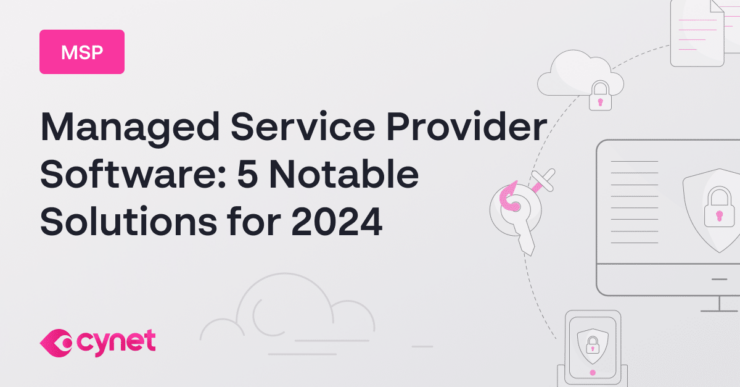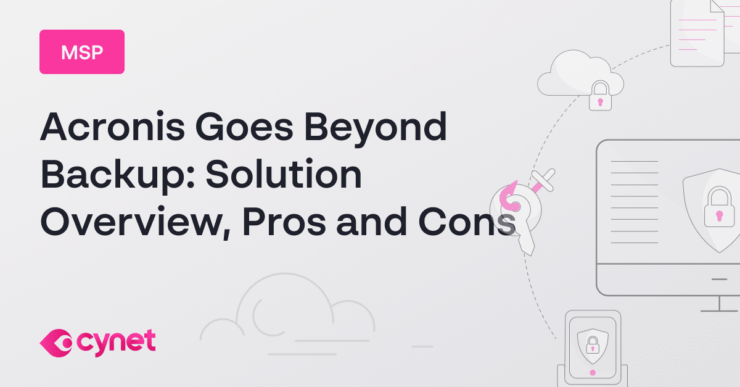What Is the Role of Managed Service Providers in Cybersecurity?
Cybersecurity refers to the protective measures employed to defend computers, servers, mobile devices, electronic systems, networks, and data from digital attacks. Most MSPs offer cybersecurity services, helping their clients protect sensitive information and IT resources from breaches and attacks. MSPs that strongly focus on security in their service offering are known as managed security service providers (MSSPs).
As an MSP, your role includes managing the security of your clients’ IT infrastructure. This involves implementing security measures such as firewalls, anti-malware software, and encryption. You are also responsible for ensuring that these security systems are up-to-date and effective in preventing the latest cyber threats.
Moreover, MSP cybersecurity is not just about implementing protective measures. It also involves monitoring for security incidents and responding to them. This includes identifying and analyzing the threat, containing and eradicating it, and then recovering from the incident. Lastly, it also involves reporting the incident to the client and advising them on steps to prevent future occurrences.
This is part of a series of articles about MSSP Security
How Common Are Cybersecurity Attacks on SMBs?
MSPs are commonly hired by small and medium-sized businesses (SMBs). There is a misconception that SMBs are not at high risk of cyber attacks, because they are not high profile organizations and not specifically targeted by hackers.
However, the reality is quite the opposite. SMBs are very frequently targeted by cybercriminals due to their perceived lack of robust security measures. According to Accenture’s Cybercrime Study, 43% of cyberattacks are aimed at small businesses. The consequences of these attacks can be devastating for SMBs, often resulting in significant financial losses, reputational damage, and even business closure in some cases.
The data shows that small businesses are equally, if not more, at risk than large corporations. Despite this, many SMBs still fail to implement adequate security measures. According to the Ponemon Institute, 51% of small businesses admit to having no cyber security defense plan in place. MPSs offer a viable solution, by providing security services as part of their managed IT service package.
How MSPs Can Help Prevent Cybersecurity Threats
Malware
Malware, short for malicious software, is a broad term used to describe any software designed to harm or exploit any computing device or network. It includes viruses, worms, trojans, ransomware, spyware, adware, and more. MSPs use a combination of advanced antivirus and anti-malware solutions to detect, isolate, and eliminate malware before it can cause damage to your systems.
Furthermore, MSPs ensure that anti-malware tools are always up-to-date with the latest threat definitions. They also monitor your systems round-the-clock for any abnormal activity that might suggest a malware infection. In case of a malware attack, they are equipped to respond promptly, minimizing any potential damage to your systems and data.
Ransomware
Ransomware is a type of malware that encrypts a victim’s files, making them inaccessible. The attacker then demands a ransom from the victim to restore access to the data upon payment. MSPs can help protect your business against ransomware by implementing a robust data backup and recovery strategy. By regularly backing up your data and storing it in a secure, off-site location, an MSP ensures that you can quickly recover your data in the event of a ransomware attack.
MSPs also use advanced threat detection tools to identify and prevent ransomware attacks before they can encrypt your files. They also provide education and training to your staff to help them recognize and avoid potential ransomware threats.
Endpoint Attacks
Endpoint attacks target the devices (or endpoints) that connect to your network, such as laptops, smartphones, and tablets. MSPs help safeguard against endpoint attacks by implementing endpoint security solutions. These solutions can include advanced anti-malware software, firewalls, and intrusion prevention systems.
Moreover, MSPs ensure that all your devices are regularly updated with the latest security patches. They also monitor your endpoints for any suspicious activity that could indicate an attack. With an MSP on your side, you can be confident that your endpoints are protected against threats.
Network Attacks
Network attacks involve attempts to disrupt, destroy, or illegally access a network. MSPs help protect against these attacks by implementing robust network security measures. This includes setting up firewalls, configuring routers and switches securely, and monitoring network traffic for any signs of unusual or malicious activity.
MSPs also carry out regular network vulnerability assessments to identify any potential weak points in your network that could be exploited by attackers. Additionally, they help ensure that your network is designed with security in mind, using techniques such as network segmentation to limit the potential impact of an attack.
Attacks Against SaaS Applications
Software as a Service (SaaS) applications have become a staple in many businesses. However, they can also be targets for cyberattacks. MSPs help protect your SaaS applications by implementing appropriate security measures, such as multi-factor authentication and encryption, and also ensure the applications are configured properly so as to not introduce risk.
Additionally, they monitor your SaaS applications for any signs of unusual or malicious activity. They also work closely with your SaaS providers to ensure that they are following best practices for security and data protection.
Related content: Read our guide to MSSP vs MSP
In my experience, here are tips that can help you better adapt to the topic of the role of Managed Service Providers (MSPs) in cybersecurity:
- Integrate Security into IT Management: Ensure that security is a central part of all IT management processes to provide a more comprehensive and proactive approach.
- Utilize Advanced Behavioral Analytics: Adopt tools that use behavioral analysis to identify anomalies and detect sophisticated threats like insider attacks or zero-day exploits.
- Leverage Incident Response Playbooks: Have predefined, tested incident response playbooks to ensure a faster, more coordinated response to security incidents.
- Offer Layered Security: Provide clients with a multi-layered approach to security, combining endpoint protection, network monitoring, threat intelligence, and data encryption.
- Focus on Continuous Vulnerability Management: Adopt continuous vulnerability scanning and assessment to identify and remediate risks in real-time.
These tips provide a solid foundation for MSPs to enhance their cybersecurity offerings and provide their clients with a more secure and resilient IT environment.
Eyal Gruner is the Co-Founder and Board Director at Cynet. He served as the company’s CEO for nine years, guiding its growth from the very beginning. He is also Co-Founder and former CEO of BugSec, Israel’s leading cyber consultancy, and Versafe, acquired by F5 Networks. Gruner began his career at age 15 by hacking into his bank’s ATM to show the weakness of their security and has been recognized in Google’s security Hall of Fame.
Cybersecurity Best Practices for MSPs
1. Deploy Anti-Malware and Anti-Ransomware
Anti-malware and anti-ransomware software are the first line of defense in MSP cybersecurity efforts. Malware and ransomware can infiltrate systems in numerous ways, from emails and malicious website links to software vulnerabilities. Therefore, implementing robust anti-malware and anti-ransomware software is a necessity. They work by scanning incoming files or code and blocking or isolating any that are suspicious or known to be harmful.
It’s beneficial to use software that includes heuristic detection and behavioral profiling. This allows the software to identify harmful files or code even if it’s a new, unknown threat. Heuristic detection works by analyzing a file or code’s behavior and characteristics, enabling it to identify potential threats even if they’re not in its database of known threats. Behavioral analysis identifies operating system processes that behave suspiciously or appear to be malware, even if they do not match a known malware pattern.
2. Deploy Endpoint Security Solutions
Endpoint security solutions are crucial for safeguarding the endpoints of client networks, including laptops, desktops, servers, and mobile devices. These endpoints are often targeted by cybercriminals as they are access points to the network. Endpoint security solutions commonly include anti-malware software but also provide additional defense mechanisms, including device firewalls, intrusion detection and prevention, and data encryption.
Advanced endpoint protection solutions also include endpoint detection and response (EDR) capabilities. EDR tools monitor endpoint and network events and record the information in a central database where further analysis, detection, investigation, reporting, and alerting take place. This proactive approach allows MSPs to detect and respond to threats swiftly, minimizing the potential impact on the client’s business.
However, EDR must be operated by qualified security analysts. If you don’t have sufficient security expertise in-house, consider solutions that offer managed detection and response (MDR), where EDR is operated by the security vendor as a managed service.
3. Monitor IT Infrastructure
Monitoring IT infrastructure is a crucial aspect of an MSP’s cybersecurity roles. This involves keeping an eye on all systems, networks, and devices to detect any abnormalities or suspicious activity. By continuously monitoring IT infrastructure, MSPs can identify and address potential security threats before they cause significant damage.
One way to monitor IT infrastructure is through the use of eXtended Detection and Response (XDR) systems. XDR systems collect and analyze data from various sources within an IT environment, identify suspicious events, and combine them into actionable attack timelines. This allows MSPs to detect unusual activity that could indicate a security threat and rapidly respond. XDR systems simplify investigation of complex security incidents and can also automatically respond to a wide range of threats.
4. Follow Zero Trust Principles
Zero trust is a security model that assumes all users, both inside and outside the network, are potential threats and therefore must verify their identity before gaining access to resources.
Implementing a zero trust model involves several steps. Firstly, it’s necessary to identify sensitive data and where it resides. Next, MSPs must enforce strict access controls, ensuring only authorized users can access this data. Additionally, it’s important to continuously monitor and log all activity on the network.
Zero trust is closely related to the principle of least privilege (PoLP), where a user is given the minimum levels of access necessary to complete his or her job functions. This approach minimizes the potential damage if an account is compromised as the account will have limited access to the system.
5. Have a Disaster Recovery Plan
Having a disaster recovery plan is an essential component of MSP cybersecurity. In the event of a cybersecurity incident, a disaster recovery plan guides the response to minimize damage, restore services, and recover lost data.
A robust disaster recovery plan should outline the steps to be taken in the event of various types of incidents, from data breaches to natural disasters. It should also identify the individuals responsible for executing these steps and detail how to communicate with stakeholders during the incident.
Regular testing of the disaster recovery plan is also crucial. This ensures everyone knows their roles and responsibilities, and that the plan is effective. After testing, it’s important to review and revise the plan as needed, incorporating any lessons learned.
6. Provide Sufficient Security Training for MSP Staff
Training MSP staff in cybersecurity is a fundamental aspect of protecting client networks and data. This involves regular, comprehensive training sessions to ensure staff are aware of the latest cyber threats and the best practices for preventing them. Training should cover a range of topics, from recognizing and responding to phishing emails and other social engineering attacks to the correct implementation and maintenance of security software and hardware.
In addition to the initial training, it’s vital to establish a culture of continuous learning and awareness. This can be achieved through regular updates on new threats, refresher courses, and simulations of cyber attacks to test staff responses in a controlled environment. Also, staff should be educated on the importance of following security policies and procedures, such as secure password practices and the proper handling of sensitive data.
7. Invest in a Holistic Cybersecurity Platform
A holistic cybersecurity platform can be a powerful tool for MSPs offering security services. Such a platform provides a comprehensive suite of tools to protect against various types of threats, from malware and ransomware to endpoint attacks and insider threats.
A holistic cybersecurity platform can include features like endpoint protection, network security, data protection, and threat intelligence. Advanced solutions are based on XDR, which unifies security capabilities to provide protection across silos and automate responses. By integrating these capabilities into a single platform, MSPs can streamline their security operations and ensure no gaps in protection.
It’s important to choose a platform that’s scalable and flexible, as the needs of an MSP and its clients can change over time. Additionally, prefer a platform that offers access to external security experts, to avoid relying only on in-house security expertise. This will allow you to provide faster and more effective response to security incidents.
Learn more in our detailed guide to it managed services.
Cynet: The Ultimate Cybersecurity Platform for MSPs
Cynet is a comprehensive cybersecurity platform for service providers. It streamlines cybersecurity by combining multiple critical security functionalities into a single, multitenant platform. This integration enables Cynet to offer endpoint, user, network, and SaaS security features that would typically require multiple products to achieve.
The platform features advanced capabilities such as Next-Generation Antivirus (NGAV), Endpoint Detection and Response (EDR), User Behavior Analytics (UBA), network analytics, deception technology, and Software-as-a-Service (SaaS) Security Posture Management (SSPM). These tools work together to detect and eliminate hidden threats. Cynet’s platform also includes automated incident resolution capabilities. It utilizes customizable playbooks and a range of remediation actions, enabling threats to be automatically resolved without manual intervention.
Additionally, Cynet supports its platform with the CyOps Managed Detection and Response (MDR) team. This team provides 24/7 monitoring of customer environments to quickly address any suspicious activity and respond to inquiries from both service providers and their clients. The multitenant nature of the platform makes it especially suitable for Managed Service Providers (MSPs) and Managed Security Service Providers (MSSPs), making it easy to manage services across multiple clients.
Learn more about Cynet for MSPs



